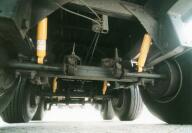How Reliable is Your Truck Fleet
New independent tests highlight the dangers of worn shocks on trucks
Tenneco Automotive, producer of the Monroe Magnum range of shock absorbers for trucks and trailers, is urging fleet operators and truck owners to get their vehicles' shocks checked on a regular basis in the light of new research, to avoid the dangers and high costs of operating with worn components.
New comparative tests carried out by the German Vehicle Inspection Agency (TÜV), provide conclusive evidence that a truck and trailer fitted with 50% worn shock absorbers can have a braking distance up to 28.3% longer than the same vehicle fitted with 100% efficient 'new technology' Monroe Magnum shock absorbers, when cornering on an uneven road surface.
The independent research also demonstrated that the same truck and trailer with worn shocks is more difficult to control in a collision avoidance manoeuvre, thereby extending the risk to the truck driver and other road users.
 In total, five different tests involving emergency steering and braking manoeuvres were used to determine the exact effects of shock absorbers on the handling performance of a modern truck. All the tests provide clear evidence that worn shock absorbers greatly reduce the driving safety of a heavy goods vehicle (HGV) by minimising 'tyre to road' contact.
In total, five different tests involving emergency steering and braking manoeuvres were used to determine the exact effects of shock absorbers on the handling performance of a modern truck. All the tests provide clear evidence that worn shock absorbers greatly reduce the driving safety of a heavy goods vehicle (HGV) by minimising 'tyre to road' contact.
In the light of these latest findings, Tenneco Automotive is advising fleet operators to regularly check shock absorbers before it is too late, and not to wait until the unit is broken, or causing tyre wear. This should be done primarily for safety reasons, while also helping fleets to avoid incurring high costs resulting from a vehicle's downtime, as well as tyre wear or increased fuel consumption, which could be caused from driving with worn out shocks.
Warns Jean Michel Deprez, product manager heavy duty of Tenneco Automotive: "The results from all the comparative tests highlight the clear dangers that exist when driving an HGV with ineffective shock absorbers."
"Worn shock absorbers reduce the maximum 'tyre to road' contact vitally important for manoeuvres such as emergency braking and steering. Even when fitted with safety systems such as anti-lock braking systems (ABS), an HGV with worn shocks can lead to lethal consequences."
"A regular shock absorber check can be a life-safer and the basis for important savings for fleet operators who need to ensure this is done professionally every 65,000 kilometres (40,000miles) or during their brake checks"
Previous tests conducted by Tenneco Automotive on car drivers also show that worn shock absorbers increase driver stress levels and fatigue, and slow down reaction time by more than 25% - reducing driver performance in the event of an emergency.
 Designed to meet vehicle manufacturers' requirements, the Monroe Magnum range of shock absorbers is suitable for most European trucks - rigid and articulated - weighing from 3.5 to 41 tonnes and for axles up to 12 tonnes, including ERF, Fiat, Foden, Ford, Iveco, DAF, MAN, Mercedes, Renault (RVI), Scania and Volvo. The range is also suitable for trailer suspensions produced by BPW, Fruehauf, Gigant, Granning, Hendrickson, Lohr, ROR, SAF, Tadchurch, Trailor, Weweler and York.
Designed to meet vehicle manufacturers' requirements, the Monroe Magnum range of shock absorbers is suitable for most European trucks - rigid and articulated - weighing from 3.5 to 41 tonnes and for axles up to 12 tonnes, including ERF, Fiat, Foden, Ford, Iveco, DAF, MAN, Mercedes, Renault (RVI), Scania and Volvo. The range is also suitable for trailer suspensions produced by BPW, Fruehauf, Gigant, Granning, Hendrickson, Lohr, ROR, SAF, Tadchurch, Trailor, Weweler and York.
Magnum shock absorbers use high performance oil to ensure that the shock can perform at extremes of temperature (-40¡ to +200°) and each shock absorber carries a two-year performance guarantee.
The TÜV Tests
Test details:
To test the effect of worn shock absorbers on the handling and steering of a truck and semi-trailer during emergency driving manoeuvres.
Test vehicle:
The scientific tests used a 40ft, DAF 95 XF truck and Groenewegen semi-trailer equipped with three BPW axles and ABS brakes. The vehicle was first fitted with modified shock absorbers to represent 50% wear. The tests were then repeated on the same vehicle, but this time using new Monroe Magnum shock absorbers. The same vehicle was used for each test in order to rule out variations between different vehicles.
In both instances, the vehicle was fitted with sophisticated measurement equipment to ensure precise and accurate recordings. The DAF 95 XF truck was used as it is a popular commercial model throughout Europe.
Test results:
- Straight line full braking on an uneven road (initial speed 50km/h = 31mph). Emergency braking using a fully laden vehicle with worn shock absorbers showed an increased braking distance of 1.8 metres when compared with the same vehicle fitted with 100% efficient Monroe Magnum shock absorbers. With an empty truck, the figure increased to 4.5 metres.
- Straight line full braking with an avoidance lane change on an uneven road. On a wet road surface and from a speed of 50km/h, the braking distance of the fully laden vehicle with 50% worn shock absorbers was 4.1 metres longer than with 100% efficient shocks. With an empty vehicle the figure was 4.6 metres.
- Braking while cornering on an uneven road. When braking while cornering on wet pavement from a speed of 35km/h (22mph), the braking distance of a fully loaded vehicle was 1.4 metres longer than when it was repeated with new shocks. With an empty vehicle on dry pavement this figure increased to a massive 3 metres.
- Cornering on an uneven road. When cornering on an uneven dry road with a fully loaded vehicle, the vehicle's turning velocity was reduced by 2.3 km/h and with an empty truck, 4.8 km/h when using worn shocks.
- Straight ahead driving with constant speed on an uneven road. Here, when driving a fully laden truck with worn shocks, greater effort was required to steer the truck, with the trailer's suspension 59.7% less effective with a fully loaded vehicle and 62.6% less with an empty vehicle.
Conclusion:
Driving with 50% worn shock absorbers not only puts the vehicle and its driver at risk, but also the safety of other road users. Checking shocks regularly for wear can improve the safety of a vehicle, and reduces the overall costs for a fleet by avoiding vehicle downtime and maximising component lifetime.
